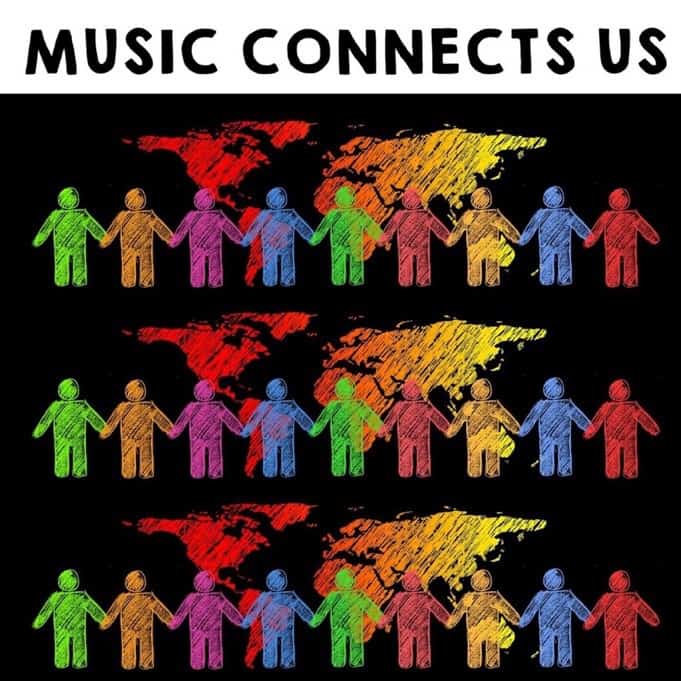Sound Perimeter: How Music Connects Us

Table of Contents
The Neurological Basis of Musical Connection
Music's power to connect isn't merely subjective; it's rooted in our neurology.
Mirror Neurons and Shared Emotion
Mirror neurons, the fascinating cells in our brains that fire both when we perform an action and when we observe someone else performing it, play a crucial role in empathy. Music powerfully activates these neurons. When we listen to music, particularly with others, we're not just passively receiving sound; we're actively mirroring the emotional expressions conveyed through the music.
- Studies have shown significant brainwave synchronization among individuals listening to music together, indicating a shared emotional experience.
- The release of endorphins, our natural mood boosters, and oxytocin, the "love hormone," during shared musical experiences further enhances the feeling of connection and bonding.
Music's Impact on Emotional Regulation
Music isn't just about pleasure; it's a powerful tool for emotional processing and regulation. This capacity makes it particularly effective in fostering a sense of community, especially during challenging times.
- Music therapy utilizes the power of music to help individuals cope with trauma, grief, and other emotional difficulties.
- Many cultures have collective mourning rituals involving music, creating a shared space for grief and healing within a community.
- Community singing events, like gospel choirs or karaoke nights, provide a unique space for emotional expression and social bonding.
Cultural and Linguistic Bridges
Music transcends language; it's a truly universal language.
Music as a Universal Language
While words may differ, the emotions conveyed through rhythm, melody, and harmony are largely universal. This allows music to break down cultural barriers and connect people from vastly different backgrounds.
- Globally popular genres like pop, rock, and electronic music demonstrate the universality of certain musical elements and their appeal across cultures.
- Artists like Beyoncé, BTS, and others enjoy global popularity precisely because their music resonates with shared human experiences of love, loss, joy, and struggle.
- Rhythm and melody are foundational elements that convey basic emotions like happiness, sadness, excitement, and calmness, regardless of linguistic background.
Shared Musical Rituals and Traditions
Music plays a central role in cultural rituals and traditions worldwide, cementing social bonds and strengthening community ties.
- Traditional folk music often tells stories of a community's history, values, and beliefs, creating a sense of shared identity.
- Religious chants and hymns in various faiths provide a framework for communal worship and spiritual connection.
- Dance music, from traditional folk dances to contemporary club music, facilitates physical and emotional connection through shared movement and rhythm.
The Power of Music in the Digital Age
The digital age has revolutionized the way we experience and share music, expanding the reach of the sound perimeter.
Social Media and Musical Communities
Online platforms have fostered vibrant musical communities, allowing individuals to connect with like-minded people across geographical boundaries.
- Music streaming services like Spotify and Apple Music facilitate the discovery and sharing of music, exposing individuals to diverse genres and artists.
- Collaborative music-making platforms connect musicians from around the world, enabling them to create music together despite physical distance.
- Fan communities on social media platforms allow fans to engage with their favorite artists and connect with fellow enthusiasts.
Collaborative Music-Making and Shared Creativity
Collaborative music projects promote a powerful sense of shared accomplishment and community.
- Open-source music projects, where musicians contribute to a larger piece of music, foster a sense of shared ownership and creativity.
- Online jam sessions, where musicians improvise and create music together in real-time, create intimate and engaging musical experiences.
Conclusion
Music's ability to create a powerful "sound perimeter," connecting individuals and communities across geographical, cultural, and linguistic boundaries, is undeniable. From the neurological basis of shared emotional responses to the cross-cultural power of musical traditions and the collaborative potential of online platforms, music consistently demonstrates its capacity to unite us. We've explored the science behind this connection, examined its role in bridging cultural divides, and witnessed its evolution in the digital age. To truly experience the transformative power of this shared musical experience, actively engage with music: attend a concert, join a choir, explore diverse musical genres, or even collaborate on a musical project. Expand your sound perimeter and discover the profound connections waiting to be made through the universal language of music.

Featured Posts
-
 Healing From A Love Monster Relationship Steps Towards Recovery And Self Love
May 22, 2025
Healing From A Love Monster Relationship Steps Towards Recovery And Self Love
May 22, 2025 -
 Southport Racial Hate Crime Tory Councillors Wife Sentenced
May 22, 2025
Southport Racial Hate Crime Tory Councillors Wife Sentenced
May 22, 2025 -
 Wife Of Tory Councillor To Fight 31 Month Prison Term For Online Hate Speech
May 22, 2025
Wife Of Tory Councillor To Fight 31 Month Prison Term For Online Hate Speech
May 22, 2025 -
 Ispovest Vanje Mijatovic Razvod I Borba Sa Medijima
May 22, 2025
Ispovest Vanje Mijatovic Razvod I Borba Sa Medijima
May 22, 2025 -
 Arne Slot Did Liverpool Get Lucky Against Psg World Class Goalkeeping The Deciding Factor
May 22, 2025
Arne Slot Did Liverpool Get Lucky Against Psg World Class Goalkeeping The Deciding Factor
May 22, 2025
Latest Posts
-
 Half Domes New Client Abn Group Victoria
May 22, 2025
Half Domes New Client Abn Group Victoria
May 22, 2025 -
 Abn Group Victoria Awards Media Account To Half Dome
May 22, 2025
Abn Group Victoria Awards Media Account To Half Dome
May 22, 2025 -
 Half Dome Secures Abn Group Victorias Media Account
May 22, 2025
Half Dome Secures Abn Group Victorias Media Account
May 22, 2025 -
 Abn Amro Analyse Van De Aex Prestatie Na Kwartaalcijfers
May 22, 2025
Abn Amro Analyse Van De Aex Prestatie Na Kwartaalcijfers
May 22, 2025 -
 Half Dome Wins Abn Group Victoria Media Account A Major Public Relations Victory
May 22, 2025
Half Dome Wins Abn Group Victoria Media Account A Major Public Relations Victory
May 22, 2025
